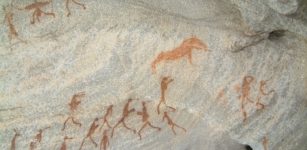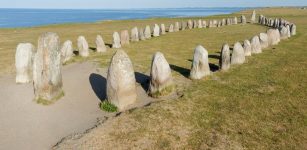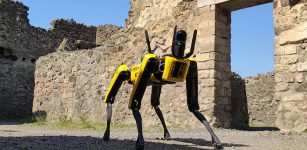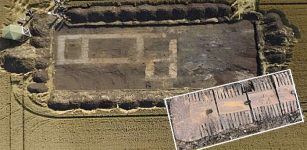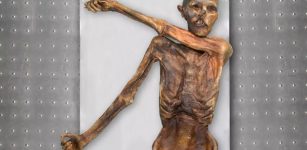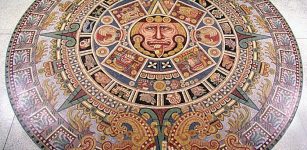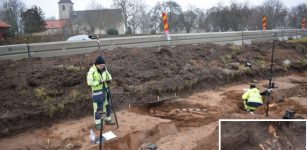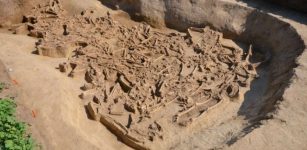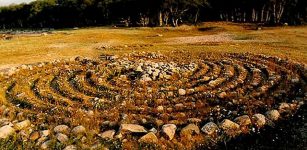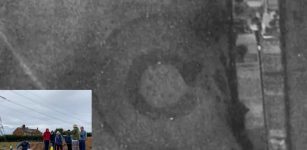Ancient Human Traces Found In The Inhospitable Namib Desert
Conny Waters - AncientPages.com - Scattered throughout the Namib Desert is a significant collection of stone tools, largely unrecognized due to challenging access conditions. The region has scarce roads and restricted vehicular entry within this protected area of western Namibia's desert. Could ancient humans have once lived here, and if so, who were they? Scientists decided they wanted an answer to this question.
Credit: Wits University
In pursuit of potential archaeological sites, Professor Dominic Stratford and Dr. George Leader embarked on an expedition across one of the world's most arid and inhospitable deserts, navigating the terrain on foot. These scholars, from the University of the Witwatersrand and the College of New Jersey, respectively, have a longstanding connection with Namibia. Their objective was to trace the ancient path of the Tsondab River, which historically flowed from the central escarpment westward to the sea—now within Namib Naukluft National Park. By following this riverbed, they aimed to uncover evidence of human and hominin activity in this prehistoric landscape.
The journey spanned over 160 kilometers through gravel plains and sand dunes rising over 100 meters above interdune flats. Namibia remains relatively unexplored in archaeology and paleoanthropology; no early hominin fossils have been discovered thus far.
Nevertheless, Stratford is confident such relics exist within these sands, awaiting discovery. In her explorations during the 1980s across southern Namibia, anthropologist Myra Shackley documented numerous isolated sites where she identified handaxes from the Earlier Stone Age and areas abundant in Middle Stone Age tools, including several locations deep within Namib Sand Sea territory.
Over the past four years, a small team of interdisciplinary paleoscientists, led by Leader, has researched at two specific sites to gain insights into their age and the survival strategies of the hominins who crafted stone tools in the desert. Shackley's initial discoveries and data gathered from this new research project inspired Leader and Stratford to embark on their expedition in June.
"We decided, the best thing to do to really understand the distribution of sites across the landscape would be to get a good transect across the desert," Stratford explains in a press release.
Reaching their destination required significant effort, as the pair had to carry all necessary supplies for their expedition. They started their journey just north of Solitaire, a small town near the eastern boundary of Namib-Naukluft National Park.
Credit: Wits University
Their strategy included receiving resupplies by vehicle three times as they made their way toward the sea. In addition to carrying items on their backs, they also used a cart to transport most of their water and food. However, they soon realized that the challenge was greater than anticipated; navigating the towering dunes while pulling a cart proved to be extremely demanding.
"It was horrible, we budgeted for about one mile an hour, and that first day we hit the dunes, we did one mile in five hours," says Stratford.
They quickly learned to identify the more compact sand on the dunes, which enabled them to climb more efficiently. For 12 days, they trekked across the vast desert landscape, walking 10 hours each day. Temperatures soared to 38 degrees Celsius during the day and dropped to a chilly 5 degrees at night. During their journey, they faced a two-day sandstorm and encountered heavy fog and fine, cold rain near the coast that drenched everything and complicated their navigation across the dunes. Stratford nearly missed this expedition; just three weeks before departing for Namibia, he found out he had to have his appendix removed.
Stratford was fortunately well enough to walk as they embarked on their journey. In case of any issues, satellite trackers were in place to monitor their movements, and a helicopter stationed in Walvis Bay was ready for emergency evacuations if necessary.
During their expedition along the river's length, they collected sediment samples to determine how long ago the river flowed and its strength at that time. The river remains largely mysterious, with its course and length still unclear. However, small patches of river deposits and ancient ephemeral pans between the dunes provide insights into the river's path and human activity in the desert. Remarkably, they discovered exceptionally well-preserved stone tools during their exploration.
"There were artifacts everywhere, and some of them were quite stunning," says Stratford.
Some of these tools might be 1.4 million years old, made at a time long before the arrival of modern humans. The more recent tools, however, may date back to between 200 and about 30 thousand years.
Credit: Wits University
In the past, the landscape that Stratford and Leader traversed significantly differed from today's hyper-arid desert. Fossils found in the area indicate that animals like elephants and antelopes once inhabited the region along the Tsondab River and its pans. These creatures thrived when the river resisted being overtaken by advancing dunes.
"People have claimed that the Namib Desert is the oldest desert and it's been like this for many millions of years. In reality, it has changed a lot through its history, with pulses of wetter periods punctuating a landscape becoming increasingly arid," says Stratford in a press release.
During their expedition, the team discovered over 40 new archaeological sites spanning almost the entire transect length from east to west. This journey left them with many unanswered questions about the ancient river and its explorers from thousands of years ago. One intriguing question is why humans and earlier hominins ventured into such challenging areas when regions with abundant water, rich flora, and fauna were relatively nearby, just 200 kilometers away.
Credit: Wits University
In future endeavors, Stratford and Leader plan to return to Namibia for another exploratory overland trek. They aim to investigate further some of the large pans they briefly sampled during their initial walk. Additionally, they seek methods for excavating the isolated archaeological sites they uncovered.
While traversing this harsh environment, Stratford gained a new perspective on those ancestors he seeks to understand better.
See also: More Archeology News
"It's very easy to drive out to an archaeological site, and not really get a sense of what it takes to be there. But when you've walked in and you're sitting there surrounded by dunes, and you sleep there, and you get smashed by a sandstorm or two, then you start to ask some questions about why you made those choices, and also why those hominins that were there thousands of years ago would also be making those choices," Stratford says.
Written by Conny Waters - AncientPages.com Staff Writer









